Bacil Donovan Warren's Blog, page 3
February 25, 2021
Hours and days blur
In the preparation for writing my book, as well as revisiting reference materials while preparing these 30th anniversary posts, one thing was made stunningly clear: while I really don’t have a lot of specific memories of the second day (25 FEB 1991), it’s because pretty much all that we did was drive northward … and drive some more … and drive even more. So it’s not as if things happened and I forgot them, it’s that no, really, there just wasn’t much of note going on.
Except … well, I was still awake. I think pretty much all of us had zero opportunity to get even the cattiest of naps, and instead relied on (initially) brief occasional dumps of adrenaline as new orders arrived, reports of possible enemy contact were relayed over the radio, or we were approaching control points and objectives that were potentially defended.
That didn’t work forever, though. By the time of sunrise on the 25th, I was exhausted. With the sun up, it would be a lot easier to fight off the tired, and the chilly air helped too. Of course I was wearing the CVC coveralls and my CVC tanker’s jacket, my CVC helmet, and goggles—always goggles while moving, just like always gloves while on the tank in general—but I also had on the CVC balaclava, which worked really well at keeping most of the cold (and the dirt) off my face. Not all of it, though, because there always seemed to be edges where wind would cut through and smack my skin. Not much to do about that except adjust things occasionally when one part would get too cold or dried out. It did help that I was mostly facing to the left rear of the tank, with my loader’s M240 machine gun oriented that way as well, so I think the LT probably had the worst of that biting, piercing cold. This is something that is reasonably easy to replicate, in fact. The next time you’re the passenger in a car in the wintertime, put on a ski mask or balaclava and some goggles and stick your head out of the window while the driver maintains a 20-30 kilometer per hour pace. That’s what we’re talking about here.
Challenges and solutionsAs the air, rear, and left-side guard, it’s important to scan both the horizon and the visible ground in those areas, and keep vigilant. It can be difficult to do under even normal circumstance, but after having been awake more than 28 hours in a row it becomes a constant struggle. Not only a struggle to maintain situational awareness, but also one to avoid a desert combat version of “white line fever” (a.k.a. “highway hypnosis”)—becoming mesmerized by the passing, mostly unchanging desert landscape, dulling reaction time and even creating pretty serious time compression, where minutes or even hours of time can pass with no conscious recollection.
So once past the first 24 hours or so, the challenge is to maintain that focus. One way would be to get some sleep—but there isn’t time for that. In earlier conflicts, tank crews (and other soldiers) from many nations were issued pills that would help them with their focus, often pills that contained amphetamine or closely related compounds. The US Army did not issue these pills when I was on active duty, certainly not to any of the units that I served with. There are still rumors that perhaps pilots or SF might have had access to them, but I was not a pilot nor did I serve with any SF units, so I have no idea about that. What I do know is that we certainly didn’t have any such bullshit—pardon the language.
So how did we stay awake and maintain focus? Well, it was a struggle, and I can personally guarantee that the focus was not always at 100% … and that’s just the way it goes. I did my best, always, but I can also say that there were definitely times where I shook my head because I realized I’d succumbed to the desert hypnosis. Being a coffee drinker, I would have gotten some java juice … except that to make it, we’d need to be stationary for a few minutes, and that also wasn’t happening. I did have some Mountain Dew still left in my helmet bag in the turret, so I would pop a can of that first. Then when that stopped working, it was time for one of two magnificent concoctions, either Tanker Special Pudding (cocoa powder with the MRE instant coffee added to it, along with the sugar and creamer packets, and mixed with just a little bit of water) or Tanker Shots (MRE instant coffee, sugar packet, creamer packet, all emptied simultaneously into the mouth and swallowed with a mouthful of water).
Tanker Special Pudding is less nasty than it sounds. But it was still kinda nasty, not gonna lie. The Tanker Shots were the penultimate trick, when other things had stopped working, and that tasted awful. Don’t believe me? Go get you a jar of Taster’s Choice® and eat a spoonful of it. Just don’t say I didn’t warn you!
There were more extreme measures, but they weren’t needed yet.
As the day dragged on, hot refuel after hot refuel and phase line after phase line, night started setting in and the challenges stiffened—we still were rolling north mostly unhindered, and except for Bravo Troop’s one POW incident from the day prior we hadn’t yet made contact with any enemy forces. To be fair, this was mostly expected. We knew this part of the desert was basically devoid of anything except sand, dirt, rocks, and occasional Bedouin nomads, and that included Iraqi combat troops. They just didn’t expect anyone to be out here, so they didn’t guard it. Big mistake, as they’d find out over the next three days.

February 24, 2021
Crossing the Line of Departure
After awakening fifteen minutes prior (damn you, Army!) to stand-to, working with SGT Planter to pull the camo netting off the tank and get it neatly (yeah, right … “neatly”) stuffed into its stowage bag, Can’t Touch ‘Dis a.k.a. Cyclone White One a.k.a. C-21 is ready for combat. All personal equipment is stowed. All crew equipment is either deployed and ready to use, or is also stowed. I am sitting in the seat at my loader’s station, CVC helmet on, waiting for the countdown to start the engines—and just like that, I went from sleeping like a log to fully awake, dressed, and spoiling for a fight.
The fight didn’t come yet, however, and after everyone went to REDCON-1 we were stood down to REDCON-2 and told to await further instructions. As I’d noted in yesterday’s post, the OPORD was to begin our northward advance on day 2, 25 FEB, after the other two Corps-sized elements in CENTCOM had executed their initial battle plans. It was about 05:00 or so, and so command made the decision to just have units stay in place, eat an MRE breakfast, and wait.
I think if you ask just about anyone, not just a soldier but pretty much any human being ever, waiting for something unpleasant to happen (or, waiting for potentially unpleasant information) can be excruciating. Even people who are not prone to anxiety can get anxious, and people who are prone to it can advance to physical symptoms like chest pain, sweating, and nausea and vomiting. For a soldier wound up spring-like and prepared to pounce, however, it can border on infuriating—let’s just get it over with! They say to be careful for what you wish, you might just get it.
Timetables advancedAnd so both the fulfilling of wishes and the Army’s penchant for having soldiers get ready to get ready fifteen minutes prior to fifteen minutes prior pays off in spades on the morning of 24 FEB 1991. We were ready, then we stood down and ate and had a few moments to let ourselves relax just a touch, and then all the timetables were moved up.
First, we got a FRAGO (fragmentary order) about 0900 to be ready to initiate our combat plan starting a full day earlier than anticipated, at about 1500 hours on the 24th instead of the 25th. To be best positioned for that, we returned to REDCON-1, and then executed a road march from that assembly area into one that was only a couple of kilometers from the line of departure—a hastily-dug anti-tank berm the Iraqis had erected several months prior—and assembled into an Israeli Box. There we waited for about three hours, from roughly 1000–1300, just sitting and waiting.
In the next 90 minutes or so starting at 1300, we saw three separate flights of helicopters, some the hunter-killer teams from Regiment’s Air Cav (4th) Squadron and some from 24th Infantry Division, flying north over our rough position. Initial reports that filtered down were that both the Marine/Army and Arab coalition forces were having very little trouble with the front-line Iraqi troops, who were surrendering in groups of tens and hundreds. They were apparently reporting major advances that were not expected, and so the VII and XVIII Corps’ timetable had been advanced by several hours (in our case, nearly 24 hours). We got another FRAGO to start crossing through the berm at 14:30, and right then was when I realized how lucky I’d been to get a full night’s sleep the night before. There wasn’t going to be much sleeping on the night of the 24th, it would seem (spoiler alert: it was worse than anyone anticipated).
Our platoon sergeant, SFC Young, called everyone over in front of the tanks and we had one last-moment pep talk, basically. He reminded us that we were the best tankers, the best soldiers, in the history of the world, and that we were about to go out and prove it to everyone else. As long as we kept our wits, do as we’d trained, and kept him up to date on our fuel, ammo, water, and food supply status, he’d make sure we all got back home. SSG Miller, the TC of C-22, led a short prayer, and then two sets of supply HEMTTs (Heavy Expanded Mobility Tactical Truck) showed up: one to top off the fuel tanks of every vehicle in the troop, and one with 120 mm HEAT (high explosive anti-tank) rounds for the two tank platoons plus the CO’s tank—a HEAT round for the breech, since we’d been carrying a full load of 40 rounds of main gun service ammo, sabot and HEAT, for several months. This was the capper.
A Berm Not Far At All (and definitely not too far)Although I took the above and below photos as we were actually breaching the berm, we were close enough to see it with binoculars from our Israeli Box.
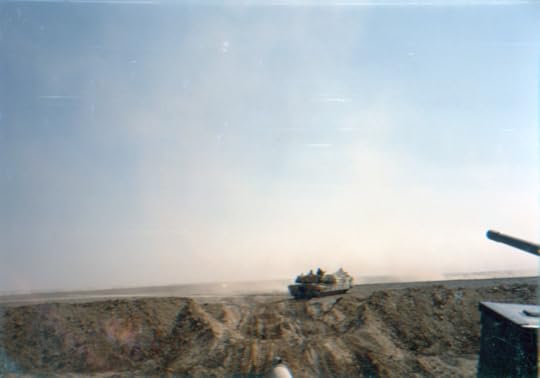
We went to REDCON-1 about 1400 local time, and then within a few minutes units began to cross in their sectors. As I note in my book, we were playing music from my Walkman® on our intercom—”The Shortest Straw” by Metallica—as we crossed over the berm, although once we had crossed over the berm and gotten past our initial phase line (PL CANOE) a few kilometers north, I killed the music and we advanced with just the bass of tracks on packed dirt, the baritone and tenor tones of the Honeywell AGT-1500 gas turbine engine, and the soprano shrieks of the hydraulic system.
The entirety of the first day of the ground war was spent hauling ass northward, stopping only to refuel—”hot refuels” the order of the day, with vehicles refueling while engines are still running. As night fell, we found ourselves in an undulating area of desert, and I recall trying to keep my eyes out for difficult terrain ahead of us (wearing the night-vision goggles) while also keeping my eyes peeled left and rear as the air guard. One Bradley from 1st Platoon rolled over, injuring their platoon leader Lieutenant Kelly Ouderkirk and another scout. They were recovered, and LT Ouderkirk refused MEDEVAC but stayed with the medics in the troop TOC (tactical operations center) instead.
Although we didn’t see any enemy forces that day, Bravo Troop did—capturing 8 enemy POWs who were apparently stragglers, having left their units at some point in the days just before we advanced.
We advanced the rest of the night without incident—or sleep.

February 23, 2021
Fifteen minutes prior …
Fifteen minutes prior to fifteen minutes prior. That’s the theme of 23 FEB 1991. If you’re a veteran, military brat or spouse, or have been around vets much, you’ll know exactly what I’m referring to, but if not here’s a primer on “fifteen minutes prior to fifteen minutes prior.”
The 3rd Army commander wants to attack in the pre-dawn blackness of 04:00, so he tells the commanders of VII and XVIII Corps to be ready by 03:45. Those same Corps commanders, not wanting last-second surprises at 03:45, tell their division commanders to be ready by 03:30. When those commanders set their planning timetable, they also don’t want to be caught up in last-minute problems, so their orders to brigade/regimental commanders are to be ready by 03:15. Brigade/regiment COs then tell their battalion/squadron commanders to be ready by 03:00, who tell their company/troop/battery commanders to be ready by 02:45, who tell their platoon leaders to be ready by 02:30, who tell their platoon sergeant to have the platoon ready at 02:15, who tells the tank commanders to be ready by 02:00, who tell their gunners to have the tank crew ready by 01:45, and the gunner tells the other two crew members to be ready by 01:30—and the individual crew members, then, are ready by 01:15 for an event that’s scheduled at 04:00.
It’s not always fifteen minutes, either, it’s just easier to understand that way (and makes a pithy statement). After getting orders ten levels deep (from Army commanding general all the way to tank gunner), sometimes a crew will sit idly in their tank for many hours awaiting orders to “start the thing” … whatever “thing” it is.
Initial OPORDThe initial OPORD, as mentioned yesterday, was for 3d ACR, 24th Infantry Division, and 197th Separate Infantry Brigade (all, at this time, under the overall command of the 24th Infantry Division commander, then-Major General Barry McCaffrey) as well as the 82nd Airborne Division to cross the LD on the 25th, more than a full day after the initial attacks from the coalition forces directly south of Kuwait (including the US Marine Corps ground units, the “Tiger” brigade of the US Army’s 2nd Armored Division, and allied Arab forces) and the protective left-flank movement of the 101st Airborne Division and the French 6th Light Division. The VII Corps, with the US Army’s 1st Armored, 1st Cavalry, 1st Infantry, and 3rd Armored Divisions, and the 2nd ACR, as well as the UK’s 1st Armored Division, were to execute their attack toward the flanks of the Iraqi forces in western and northern Kuwait later on the 24th, once the Marines et al. had the full attention of the Iraqi forces.
Then, with the Iraqis committed to involvement with the Arab and Marine/Army forces, and VII Corps swinging around to slice through the potential Republican Guard counterattack south into the Arab/Marine units, the XVIII Airborne Corps would blitz around the VII Corps and cut off the Republican Guard from their north, sitting between Kuwait and the Euphrates river and isolating Iraqi forces in Kuwait entirely.
Getting ready to get readyHowever, there were contingencies for other developments—such as the timeline accelerating with better-than-expected success. So, even though our part of the operation wasn’t scheduled to execute until the second day, we were all moved into pre-attack assembly areas so that everybody would be ready to execute their part whenever ordered.
Thus, it was that a unit—our unit, Cyclone Troop of the Tiger Squadron of the Brave Rifles, the United States Army’s Third Armored Cavalry Regiment, as well as the entirety of the regiment and all of VII and XVIII Corps—terminated a screen line mission that had been in place for several weeks and was sitting in an assembly area waiting to start an attack that wouldn’t occur for two days.
Fifteen minutes prior to fifteen minutes prior, exponentially speaking.
One thing that I am grateful for, given what happened next, is that I did not end up with a guard shift on the night of the 23rd—so, I had a full night’s sleep before the start of Operation Desert Sabre … and the featured image, above? Actually taken that night, just before I hit the sack. It’s awesome when things like that line up.

February 22, 2021
Final days
Over the days from about the 16th to the 22nd, we continued with our mission to man our screen line, and also had several revisions to our operation plan. There had been some overtures of peace talks, and of course we continued to hope that they would bear fruit (spoiler alert: they didn’t) so that we could go home. We figured we were going home no matter what, either because Saddam will have pulled his troops out or because we will have driven them out. Generally speaking, however, the option that breaks the fewest number of mother’s and father’s hearts is the better one.
The MailAs noted last time, mail is a huge issue for soldiers in the field, and we hadn’t been getting ours. No doubt, this was confounded by two related developments: first, that we’d physically moved from our base camp into a temporary assembly area deep in the desert and then to our screen line positions; and second, that the logistical tail for the 3d ACR (and likely most, maybe all, other XVIII Airborne Corps units) was filled to overflowing with combat-essential items, and so the personal mail kept being put off in priority. It got pretty annoying, though. At one point, General Schwarzkopf had been rotating through all of the units to chat with soldiers and answer a few questions, and when he met us I asked him about our mail problems (spoiler alert: they got fixed by the time of evening chow that day).
In that late-arriving mail, I received a few replies from some of the “Dear Any Soldier” letters I’d picked up while we were in base camp. I’d replied to a bunch of them, maybe twenty or thirty total (as in I had picked up letters from that many individual authors), and there were about four or five with whom I’d developed a continuing correspondence. One of them was a college student from Pennsylvania somewhere, another was a middle-schooler from I think Indiana, another was a WW2 vet, and there were one or two others. They were all cool people in their own way, doing what they could do to help lift the spirits of a soldier ten thousand kilometers from safety (and ten million kilometers from sanity, it often seemed). The middle schooler sounded a lot like me myself when I was in middle school, and had just started playing Dungeons & Dragons®, so I shared a few tips and tricks that I’d picked up in several years of playing and DM-ing games.
Final PrepOur most recent OPORD (operation order) by the 22nd had us crossing the LD (line of departure) in the late afternoon of the 25th, anticipating that the coalition forces along the border of Kuwait would start their offensive early that morning and would be slogging their way north through the first line of Iraqi defenders. We’d settled into a final routine, and the night of the 22nd would be the last we’d spend on the screen line we’d occupied for about a month or longer. It wasn’t home, and I certainly wasn’t sad to leave it (and I doubt others shed many, if any, tears), but it also meant taking yet another step toward an abyss of violence and uncertainty that I’d hoped we could avoid. Such is the way of the modern world sometimes.
So, the last day on the screen line was the last day we received mail before the 24th, and although I wrote short replies to everyone there was not time to get them in the outbound mail before then.
Then there was the matter of those “only open on notice of…” letters. There’s a debate about those letters that rages even yet: is it a tacit acceptance of impending catastrophe—fatalism, even—to write a letter to one’s family (wife or husband, kids, or parents, mostly) about how you feel, a final “I love you” as you head off into the tusks of the elephant, or does it calm a soldier’s mind to know that, should they succumb to the violence they are about to endure, their family will have a final closing statement they can cherish?
That is a tough question with no easy answer. I am in the camp that writing it does no more harm than good, that it is simply a psychological acknowledgement of the pending danger and a wish to—as much as possible—remind those cherished friends and/or family that even to the last, they were thought of, missed, loved. I do not believe that it leads to a soldier losing all hope and acting carelessly under fire. I understand the opposing point, I just disagree with it.
For me, I wrote one. I sat down on the night of the 22nd and made sure to compose a short letter addressed to my parents and brother, the contents of which are (of course) intensely personal. I held onto it for the night of the 22nd, not yet sure if I wanted to swap with one of my troop mates, but at least I’d written it.
Now, all that was left was to get things started.

October 17, 2018
Beta reader review of Universus Respondet
October 1, 2018
Universus Respondet paperback is on sale, eBook version available for preorder
The paperback version is on sale now at Amazon.
The eBook version is in pre-order at the following bookstores online:
AmazonApple iBooksBarnes & Noble NookKoboSmashwordsThe paperback version on Amazon is linked so that if you buy the paperback, you can get the Kindle version for $0.99.
Pre-order pricing on all eBook stores is $5.99 (regular price will be $6.99, on the day of release, 23 NOV 2018), so be sure to pre-order to get the best price!
September 16, 2018
Universus Respondet update
I spent most of the weekend revising based on their feedback and sent my editor the updates earlier this evening. There were a few minor typos that escaped three rounds of editing and revising, but these have been corralled. Over the next couple of days, I will be finishing up the remainder of these revisions, and then it will be time to start the process of compiling out of Scrivener and eBook and paperback formats.
Amazon pre-sale for Universus Respondet starts on 16 November 2018, and it will cost $9.99 in eBook formats. Paperback pricing is not yet available, but when it is I will post an update.
I'm excited to get this story into the hands of readers! I believe it will appeal to Sci-Fi fans, as well as many general readers.
August 31, 2018
Save me! Backing up Scrivener projects part 3: Snapshots
Hello, and welcome to another cogitation! I hope that your summer continues to be awesome. I was able to fix the A/C, and now it’s working quite well, so this Tucson summer has been bearable.
In the “Save me!” series, I’ve talked about autosaves and automated backups in Scrivener proper, and the different ways that it can help save your hard writing work from falling prey to disaster. I also discussed the Automator tool for macOS, and how I have it set up so that I can make additional externally stored backups of important milestone versions of my Scrivener projects.
Today, I’d like to talk about one additional piece, the Snapshot feature of Scrivener, and how it works to help preserve your sanity (and documents!) while working on your project.
What is a Snapshot?
In Scrivener, a Snapshot is essentially a date stamped copy of the text of a document (text only, not any metadata), and it is stored as a part of the document. I am not aware of any technical limit on the number of Snapshots a given document can have, but as we’ll see in a moment it isn’t usually necessary to keep more than about a half-dozen, maybe ten, of any given document.
A Snapshot is more than just a verbatim copy of that text, though. One of the very cool things about them is that the text in the Snapshot can be compared to the current document’s text, with added and deleted text highlighted in the Snapshot (more on this in a moment—also, note that as far as I am aware, the “compare” feature is macOS-only at this time). Snapshots can also be compared with other Snapshots, not just the current version of a document.
It is important to remember that a Snapshot only makes a copy of the text—not the keywords, metadata (custom or otherwise), notes, or other information, although it does copy the comments—and although it does preserve formatting, it doesn’t track changes in formatting.
Okay, but why would I want to use a Snapshot?
One main advantage of using a Snapshot is it gives you a touchstone for a given document’s contents. Since Scrivener does automatic saves and therefore there is no “revert” option, an excellent use for the Snapshot is to preserve the current text in a document before editing it. If you’re like many people, you have probably been conditioned to hit “save” frequently while writing (even I am conditioned this way, though I am slowly un-learning this habit). Since Scrivener does that part for you, as do many other current software programs, manually triggering a “save” isn’t really that important. Because of that, however, Scrivener doesn’t really have any way to “revert” changes (Word, Pages, other apps will do this, essentially by discarding the currently-open document and reloading it from storage).
The “revert” feature can be brought into play, though, using the Snapshot feature. There are at least a couple ways to approach this, so I’ll cover two different thoughts.
First, what I informally refer to as the “Milestone Snapshot.” This is when you have completed a milestone for a document, and consider it ready to change status from (for example) “To Do” to “First Draft.” At that point, make a Snapshot (how, shortly), change the status, and work on the next document. Repeat that until every document is a “First Draft,” and then you’ll have a Snapshot of each document as it was when you completed that draft. This is generally my workflow. In this case, the Snapshot will enable you to fall back or compare to the First Draft version when you are making your edits on the way to your Second Draft.
Second is what I call the “Experimental Snapshot.” In this case, you create the Snapshot first (though, obviously not of a blank document, that doesn’t make any sense!), and then work on the document. If you get to a point where you are like “nah, this all stinks, I don’t want these edits anymore,” you can roll back to the previous Snapshot, and the experiment is wiped clean—though, it is possible to snapshot the current document before rolling back, as we shall see shortly.
One additional approach is to have Scrivener create Snapshots of any modified documents whenever a manual save is triggered (usually via Command-S or Control-S, but also by the File->Save command). This approach will provide a sort of analogue to the Revert option in some applications, especially if combined with the “Experimental” approach.
Snapshots sound like a useful tool, how do I create one?
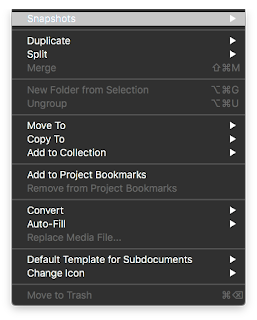
Creating a Snapshot is quite straightforward. One way is to open your Scrivener project, click on the document you want to work on in the binder, and then type Command-5 or Control-5 (alternately, click in the “Documents” menu, and select Snapshots->Take Snapshot). The snapshot will appear in the Inspector pane under the “Snapshots” tab (the “camera” icon). Another way is to create a Titled Snapshot, by typing Command-Shift-5 or Control-Shift-5, or by selecting “Take Snapshot With Title” in the Snapshots menu under “Documents.” This will pop up a text entry field prompting you for a title to give the Snapshot, and then creates the Snapshot.
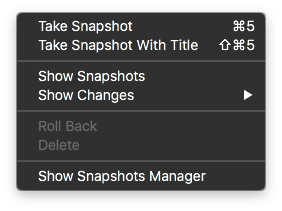
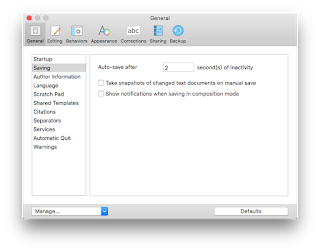 Another way is to tell Scrivener to take Snapshots of changed documents on a manual save, and then hit Command-S or Control-S, or select “Save” from the File menu. To tell Scrivener to do this, open the Preferences, click on the General tab, and click “Saving” in the left pane. In the right pane is a checkbox for “Take snapshots of changed text documents on manual save.” Click that checkbox on, and every time you manually save (via Command-S/Control-S or via “File->Save”) Scrivener will create a new Snapshot for each changed text document.
Another way is to tell Scrivener to take Snapshots of changed documents on a manual save, and then hit Command-S or Control-S, or select “Save” from the File menu. To tell Scrivener to do this, open the Preferences, click on the General tab, and click “Saving” in the left pane. In the right pane is a checkbox for “Take snapshots of changed text documents on manual save.” Click that checkbox on, and every time you manually save (via Command-S/Control-S or via “File->Save”) Scrivener will create a new Snapshot for each changed text document.It is also possible to use these commands to create Snapshots of multiple documents at once. Let’s say you’ve decided that you want to work on one chapter today, and there are several scenes in that chapter. You know you may need to work back and forth on several scenes—or, you are like me and you like to edit in Scrivenings mode—and you want to Snapshot them all before starting. You could click on each one, hit Command or Control-5 (or Command or Control-Shift-5) and make Snapshots of each one in turn, that would certainly work. If the documents are all at the same level, you could click on the top or bottom file in the list, shift-click the bottom or top file (thus selecting those two plus all files between them), and then create your Snapshot.
 Another way to do this is you could click on the chapter folder in the binder (if you organize your work this way), then click on Edit->Select->Select with Subdocuments. This will basically do what it says, select all of this item’s subdocuments. Then you can create your Snapshot as you would otherwise.
Another way to do this is you could click on the chapter folder in the binder (if you organize your work this way), then click on Edit->Select->Select with Subdocuments. This will basically do what it says, select all of this item’s subdocuments. Then you can create your Snapshot as you would otherwise.One thing to keep in mind is that a Snapshot will only work on documents that have text. So, obviously text documents can have Snapshots, but “regular” folders can’t. If, however, your folder does have text (remember that folders in Scrivener are a loose definition), then the text can have a Snapshot. If you’re not familiar with this part of Scrivener, it’s not a huge deal, just know that “folders” by themselves can’t have (and don’t need) Snapshots.
Are there any caveats when using Snapshots?
Indeed, there are a couple of things to keep in mind about Snapshots (aside from the few things we’ve covered already).Although Snapshots will preserve the formatting of your text, it will not track if or when formatting is changed—so, you can’t use the “compare” tool to easily see where formatting changes have occurred.Snapshots do take up space, just like the text in the text document. It’s not a lot of space, but it is something to keep in mind—especially if you create a lot of Snapshots. This might happen if you turn on the option to create Snapshots on manual saves, and then instinctively hit Command or Control-S every few moments.Also (as we’ll see shortly), rolling back a Snapshot is destructive, so it is important to pay attention during the process of reviewing, comparing, and rolling back Snapshots.
I’ve created a Snapshot, how do I compare (or rollback) changes?
Again, a note of caution: as of the publication of this blog post, the compare feature is a macOS-only feature.
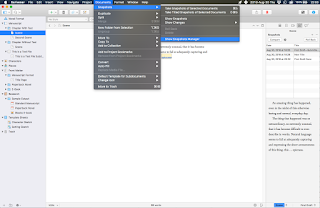 Once you’ve created a Snapshot of a document, it will appear in the list under the “Snapshots” tab in the inspector. In addition, all Snapshots in the entire project will appear in the Snapshots Manager (under the Documents menu, in Snapshots->Show Snapshots Manager).
Once you’ve created a Snapshot of a document, it will appear in the list under the “Snapshots” tab in the inspector. In addition, all Snapshots in the entire project will appear in the Snapshots Manager (under the Documents menu, in Snapshots->Show Snapshots Manager).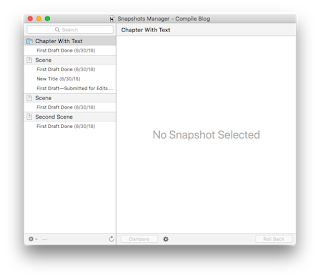

One way to look at/compare a Snapshot is to click it in the inspector, and click the “Compare” button. There, text that has been added in the current version (i.e., added since the Snapshot was taken) will show up underlined in blue, and text that has been deleted will be in strikethrough in red.
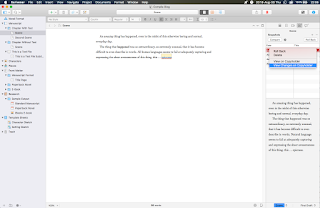
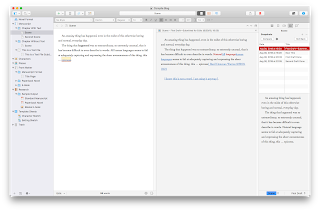
Although the inspector can be resized, it may make more sense to view the Snapshot in the editor. To do that, my favorite way is to right-click on the Snapshot, and then select “View Changes on Copyholder.” This will put the Snapshot into a copyholder window in the Editor. This makes it crazy easy to see the differences, and by scrolling line-by-line or page-by-page, it is quite simple to see where changes have been made (though, as noted, in terms of text added or deleted, not formatted differently).
There are a couple of other ways to view or compare Snapshots. One is to right-click on the Editor title bar of the document you’re interested in, and select one of the “View Snapshot” options. If you have the Editor split, or if you have a copyholder window open, you can drag the Snapshot from the inspector into the title bar for the copyholder or split window, and it will load there. Unfortunately, neither of these options shows the changes highlighted, which is why I prefer to use the “View Changes on Copyholder” option.
One additional thing you can do is compare two different Snapshots, instead of comparing a Snapshot to the current document. To do this, click on on Snapshot you’d like to use as a comparison, and then Command-click on the Snapshot with which you’d like to compare the first, and click the “Compare” button. The inspector will show you the markup (red strikethrough for deleted, and blue underlined for added), identifying the changes between the two, just like comparing between the current version and a given Snapshot.
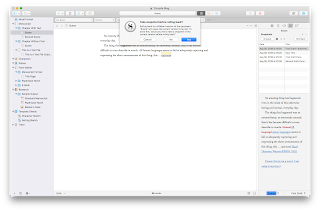 As for rolling back changes, once you’ve decided that you want to roll back to a Snapshot, select the Snapshot to which you want to roll back, and click the “Roll Back” button in the inspector. Because rolling back will destroy the current version, Scrivener will ask if you’d like to make a Snapshot of the current version of the document before rolling back the changes. If you are not 100% certain that you will not want the current version of the document, you can click “Yes” to create a new Snapshot of the current document, or “Cancel” to stop the roll back altogether.
As for rolling back changes, once you’ve decided that you want to roll back to a Snapshot, select the Snapshot to which you want to roll back, and click the “Roll Back” button in the inspector. Because rolling back will destroy the current version, Scrivener will ask if you’d like to make a Snapshot of the current version of the document before rolling back the changes. If you are not 100% certain that you will not want the current version of the document, you can click “Yes” to create a new Snapshot of the current document, or “Cancel” to stop the roll back altogether.What are some workflows that make the best use of Snapshots and other safety tools?
I can think of two primary workflows that make good use of Snapshots, automatic backups, and automatic save. Undoubtedly there are others.
One is in that “Milestone” workflow that I use myself. In this setup, automatic backups are set to occur when closing the project, and Snapshots are created when a document is ready to “graduate” to the next level of status (To Do to First Draft, First Draft to Second Draft, and so on). When I start a project, I do some basic outlining of how the manuscript will be structured, and then I go through it (not necessarily in any particular order) until I have a completed first draft. At that point, I will have finished each scene/chapter/whatever (for the first draft!), and each of them gets a Titled Snapshot. I change each document and folder to have the status “First Draft,” and then I close the project. Scrivener does a backup of the project, and once the backup is finished and the project is closed, I run my Automator action to make another backup (on external storage … actually, off-site storage, through Google Drive), so I have an additional copy of that project with all of the Snapshots. This is my First Draft milestone. I repeat that procedure for each draft that I write.
Another is to use Snapshots and backups as a fall-back (an extension of the “Experiment” idea earlier). Set the backup to run when the project is opened, and before you start editing a document, make a Snapshot of it (you can’t make a Snapshot of a blank document, so you won’t start with a Snapshot in that case). Work on it, make changes, make additional Snapshots if you like, and then when you’re done, close the project. If at any point you decide you don’t like how a document has turned out, you can roll back the changes (making a Snapshot of the current document, if you wish)—a “revert,” if you like.
If you decide you don’t like how anything turned out, you can do that to every document you changed, or you can just close the project. Since Scrivener autosaves, you can put the current project in the trash (or move it somewhere temporarily, like your Desktop), and move the most recent backup to whatever location you keep your works-in-progress. If necessary, uncompress it from the ZIP file. Now, your project is in the state it was when you opened it, before making the changes that you ended up not liking. The formerly-current project is now just an experiment that didn’t work out, so you can safely trash it (or, compress it and move to storage).
Unquestionably, these are not the only two ways these tools can be combined. One thing I didn’t mention in the Automator article was the idea of using a Folder Action. Basically, this is using an Automator app or AppleScript to watch a given folder, which will automatically perform actions when certain criteria are met (usually, when items are added to the watched folder, but there are other watchable actions).
An example workflow for using a Folder Action in addition to other workflows would be to create an Automator app that watches the Backup folder for your Scrivener project, and every time a new file was added to that folder—i.e., any time Scrivener created a backup—the Automator app would make a copy of that backup and move the copy to other storage. Another option might be to have a Folder Action that watches the /Volumes/ folder for your USB Flash Drive. When it detects that your USB Flash Drive has mounted, the action could compare a folder on the USB against the Scrivener Backups folder, and copy any files or folders it sees in the Backups folder that are not present on the USB. Bam! Instant backup, and all you had to do was create one Automator script (you don’t even have to run the script in this case, it runs itself when you plug in your USB drive).
Final thoughts
There are myriad ways to make autosave, automatic backups, Automator, and Snapshots work to help save you from the practically inevitable technology malfunctions that can drive writers insane, and help you recover from any such problems that may occur.
If you have other workflows that leverage these tools to make your life easier, or any questions about Snapshots (or any of the other topics), feel free to comment below!
August 29, 2018
New Patreon page!
After quite a lot of deliberation and consideration, I decided to launch a Patreon page ( http://bit.ly/bdw_patreon ), both as a creative spur for me and as a benefit for fans, readers, and other writers and artisanal publishers.
The purpose of my Patreon will encompass a few things, chief among them:
To provide early access to my creative writing projects (novels, short stories, poetry, and others such as that)Early access to many of my how-to, writing advice, writing tool, and review blog entries (from Scrivener to writing process, to editing and publishing, and others)Exclusive access to some things, such as behind-the-scenes coverage of media events and other public functionsAt certain tiers, early access consideration for beta reading new materials that I will publishas well as others that I haven't quite figured out yet!
If you're so inclined, come join me on the ride … we'll learn, we'll laugh, and we'll shed a few tears. It'll be fun!
August 16, 2018
Sci Fi novel Universus Respondet now in the hands of beta readers
As of right now, I am on track to publish by the end of the year, possibly sooner. As always, I will definitely let everyone know as I reach new milestones!



